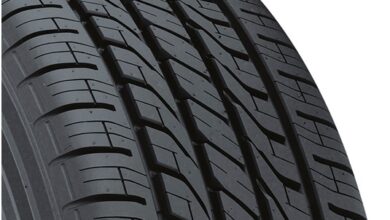How to Check Tire Pressure with a Manometer
A tire pressure gauge reliably and accurately measures the air pressure in a tire. Checking tire pressure every two to four weeks helps prevent problems that can arise from over or under-inflated tires. This article explains how to check tire pressure with different gauges. Read our article on pressure gauges to learn more about how they work.
Here you go for the Nitto Trail Grappler Review
Incorrect inflation and its causes
The tire pressure does not have to be perfect, but it must be within the optimal limit indicated in the vehicle manual. Both under-inflation and over-inflation will reduce tire performance.
low inflation
Insufficient inflation can cause:
Increased fuel consumption
-Higher rolling resistance, which means the car expends more energy to keep the tires moving at a constant speed.
-poor braking
-Irregular tread wear at the edges of the tire (Figure 2).
Causes of underinflation include:
-Permeability: A tire loses pressure through its sidewall.
-Puncture: Small nails and screws puncture a tire, causing it to lose pressure at slower rates that may go unnoticed.
-Weather: Tire pressure can drop if the temperature drops considerably. For example, if the temperature drops 5.6 °C (10 °F), the tire pressure may drop 0.07 bar (1 PSI).
excess inflation
Excessive inflation can cause:
-irregular wear
-Bad driving
-Uncomfortable driving because the tires have uneven contact with the road.
Causes of overinflation include:
-Inadequate filling: Drivers over-inflate the tire by filling it with air
-Weather: Rising temperatures can raise tire pressure. A 10°F (5.6°C) increase in temperature can increase tire pressure by 1 PSI (0.07 bar).
Types of tire gauges
There are three types of tire pressure gauges:
-Standard
-Digital
-Stick
Standard
A standard pressure gauge (figure 1) is also called a dial tire pressure gauge or an analogue tire pressure gauge. Some advanced standard indicators have functions like:
-A bleeder valve that releases excess pressure that builds up when tire temperatures rise.
-A button that deflates the tire to make small adjustments.
-A rubber extension hose that adds length to the pressure hose. This extension is ideal for trailer or caravan tires that require extra reach.
-Shock resistant dial cover up to 2 inches provides protection if the gauge is dropped.
Digital
The LCD display of a digital pressure gauge (Figure 3) makes it easy to read. It is resistant to dust and dirt and can be used in the dark. On the downside, digital pressure gauges require batteries and are bulkier than stick pressure gauges. Automatic tire inflators are often found at gas stations. It works like a digital tire gauge. They are more advanced because they connect directly to an air compressor and can deflate and inflate tires automatically.
Stick
Rod calipers resemble a pen. Key components include:
-A metal outer casing
-A plastic inner stadiometer
When air pressure is applied, the plastic inner rod comes out of the bottom of the gauge. Large numbers with division marks between them give the reading. For example, the pressure gauge in figure 4 indicates approximately 32 PSI.
How to measure tire pressure
The best time to check the tire pressure is in the morning, before using the vehicle. Cold tires give a more accurate reading. After using the vehicle, wait at least 3 hours before checking the tire pressure. If it is necessary to drive the vehicle to a gas station to check tire pressure, driving more than a mile will reduce the accuracy of the reading.
The following steps describe how to measure tire pressure:
1- Determine the recommended tire pressure
1-The recommended tire pressure is listed in the vehicle manual. It may be engraved on the inside of the driver’s door. Finally, it is also likely that it is engraved on the tire itself.
Remove the valve cap from the tire you want to check.
2- Place the head of the tire pressure gauge that has the valve stem on the air valve of the tire.
3- Read the result on the tire pressure gauge.
4- If the tire pressure is within the recommended range, replace the valve cap and move on to the next tire.
1- If the tire pressure is too high, release some air and recheck the tire pressure until it is within the recommended range.
2- If the tire pressure is too low, add air to the tire and recheck the tire pressure until it is within the recommended range.
Summary of pros and cons of tire pressure gauges
digital manometer
Pros
1- Calibration: A calibrated digital manometer is more reliable and accurate than a standard or stick manometer.
2- Ease of Use: Digital pressure gauges are easy to read.
3- Durability: Digital pressure gauges are made with more durable materials to protect the electronic components inside.
cons
1- Power: Digital pressure gauges require a power source, such as batteries.
rod pressure gauge
Pros
1- Size: Stick gauges are small and easy to store in a vehicle.
2- Ease of Use: Cling gauges have minimal components, making them easy to use.
3- Power: Stick gauges do not need an external power source.
cons
1- Accuracy: Stick gauges are less accurate than standard and digital gauges.
2- Readability: Stick gauges are not that easy to read.
standard pressure gauge
Pros
1- Features: Standard gauges come with additional features such as extension hoses and deflation valves.
cons
1- Readability: The output reading of a standard pressure gauge is not as accurate as that of a digital pressure gauge.
How does a digital manometer work?
A digital pressure gauge measures tire pressure by using a sensor and converting it into electrical signals. An integrated microprocessor converts the electrical signals into numerical values, which appear on the pressure gauge’s digital display.
Is there a difference between a motorcycle tire pressure gauge and a truck tire pressure gauge?
It depends on the pressure gauge and the valve of the motorcycle and truck. Truck tires need a higher PSI compared to motorcycles. At gas stations, most pressure gauges are designed to inflate any tire.




